| |
  Page 3 of 3 Page 3 of 3 |
| Author |
Message |
MacGyver

Guru

Joined: 12/05/2009
Location: United StatesPosts: 1329 |
| Posted: 04:31am 03 Jun 2011 |
 Copy link to clipboard Copy link to clipboard |
 Print this post |
|
Roe / Fans
Back in the day, when I had a house full of kids (3 boys, 1 princess) I ran two active collector panels mounted on a south-facing roof (USA - southern California). Each one was 3' x 10' and each collected water with a main header top and bottom and about ten (?) 1/2" risers each.
The two panels were tied in series and we had hot water 'till hell wouldn't have it. I used the same little pump then that I'm currently using to move a trickle of water through the panels. The only thing different from what I'm doing now is, the solar "loop" drew from and fed an insulated 100-gallon storage tank. No matter what you do, you MUST insulate everything or it won't happen.
My natural-gas-fired domestic water heater was fed with water from the solar application and it rarely fired.
One thing I might mention here is this: If you'll make yourself a note (I put it in my "tax" folder) to change out your water heater's anode every other year, the tank will last forever. By definition, it cannot rust if there is an anode in place whose "reduction potential" is greater than iron. That means you need either an aluminum, magnesium or aluminum-magnesium alloyed rod for an anode. They are available at your local professional plumbing supply store.
I hope this is enough information to enable you to build your own solar water heater succesfully. The panels are still available from professional plumbing supply houses, however, since there is no longer a national "tax incentive" it's back to supply and demand and since the demand is low, the price is high; sorry.
If you choose to use a profssionally-manufactured panel with the proper glass and a nice enclosure, I'd try just one and if that's not enough, buy and install another. Install them in such a way that you can merely drop another alongside the first one. Since the flow is only a trickle, you should be able to get away with tying them together with a stainless steel-braided supply flex with appropriate connectors (compression or iron pipe size) and this will make it easier for you to add another panel should that become necessary.
If you take your time, you can scrounge almost all the stuff you need to make your own for mere peanuts. If you live in a tract house and have an HOA (home-owner's association) you'll have to jump through their hoops in order to put something like this on your roof and that might mean having to purchase professional panels rather than making your own. Check it out before you wind up having to tear it off your roof because the "architectural committee" gets a burr under their sadle!
. . . . . MacEdited by MacGyver 2011-06-04
Nothing difficult is ever easy!
Perhaps better stated in the words of Morgan Freeman,
"Where there is no struggle, there is no progress!"
Copeville, Texas |
| |
Greenbelt

Guru

Joined: 11/01/2009
Location: United StatesPosts: 566 |
| Posted: 01:32pm 03 Jun 2011 |
 Copy link to clipboard Copy link to clipboard |
 Print this post |
|
Thank Mac,
This should be all that's needed to lay out a plan. and thanks for the tip about the anode in a hot water tank, I knew they had one but didn't know they could be replaced.
Cheers-----Roe
Time has proven that I am blind to the Obvious, some of the above may be True? |
| |
petanque don
Senior Member

Joined: 02/08/2006
Location: AustraliaPosts: 212 |
| Posted: 02:25pm 03 Jun 2011 |
 Copy link to clipboard Copy link to clipboard |
 Print this post |
|
the main issue when my family had a solar hot water systems 30+ years ago was in summer the water can be scaling hot.
in the winter there can be weeks when there is little heating.
in hot weather the water in the cool tap can be over 30 degrees C for for a shower little hot water is needed.
in cold weather the cool tap can be very cold ans so a lot of hot water is needed. |
| |
MacGyver

Guru

Joined: 12/05/2009
Location: United StatesPosts: 1329 |
| Posted: 10:59pm 03 Jun 2011 |
 Copy link to clipboard Copy link to clipboard |
 Print this post |
|
Crew
I took an early shower today, as I'm taking my daughter to dinner this evening and wouldn't you know the water in the solar heater was hotter than it was yesterday evening?
The skies were clear both yesterday and today, so I'm tempted to throw in with niall1's comment on the 3rd page of this post. He recommends a circuit, which recognizes a temperature diffeential between the storage tank and the collector. Incorporating this would prevent the system from radiating already-stored heat from the tank back to the roof in the event the weather is much cooler nearer the end of the "timed" circulation cycle.
Thanks for that circuit, niall1.
.....Mac
Nothing difficult is ever easy!
Perhaps better stated in the words of Morgan Freeman,
"Where there is no struggle, there is no progress!"
Copeville, Texas |
| |
MacGyver

Guru

Joined: 12/05/2009
Location: United StatesPosts: 1329 |
| Posted: 03:47am 06 Jun 2011 |
 Copy link to clipboard Copy link to clipboard |
 Print this post |
|
Free Energy Update
I'm pleased with the way this is going. Today marks exactly one month of free hot showers courtesy of our nearest star.
Leaving the throttling valve just barely cracked open seems to do the trick. This morning, for some unknown reason, the circuit my pump runs on magically quit. When I established backup electric outlets for my solar application, I made all my outdoor circuits GFCI protected, since I'm parked on concrete, a perfect ground. That's what happened; somehow a ground fault kicked things off. A quick press of the reset button fixed it, but I didn't realize it was off until things had been sitting silent for about 2 1/2 hours and there was still enough hot water for a long shower and the evening dishes!
Only in America! Okay, not really, but it just seemed like a good place to toss that in. 
I think this solar gig is a done deal and unless something goes really awry, I'll likely leave it alone and just basque in free hot water for the rest of the adventure.
The only other solar-related thing hiding in the back of my mind is a fixed solar concentrator I built back in the day. I dismanteled it because it could so easily be used as a weapon, but I may just build another one and dabble in fractional distillation again, I dunno.
Next up is that (toy) widnmill generator. It's just TOO SMALL to make it as an axial-flux rig; sorry. I redesigned the stator last night and will slap it together in the next few days. I'll post the results in "Windmimlls". It's going to be a single-phase air-core animal.
. . . . . Mac
Nothing difficult is ever easy!
Perhaps better stated in the words of Morgan Freeman,
"Where there is no struggle, there is no progress!"
Copeville, Texas |
| |
niall1

Senior Member

Joined: 20/11/2008
Location: IrelandPosts: 331 |
| Posted: 10:42pm 06 Jun 2011 |
 Copy link to clipboard Copy link to clipboard |
 Print this post |
|
"exactly one month of free hot showers courtesy of our nearest star"
cant beat that Mac ....your power company will NOT be amused ...
i read that 1 square meter of copper plate can extract near 1k of heat energy ....that seems to beat pv and wind at least when it comes to heat....
i tried the differential circuit with a test panel a while back ,our weather is not sunny so it was just an experiment (a small timer was added to the pump to circulate the existing hot water in the pipes)...it did help a lot with the balance of the system
before that things ....sometimes.. got a bit out of control...
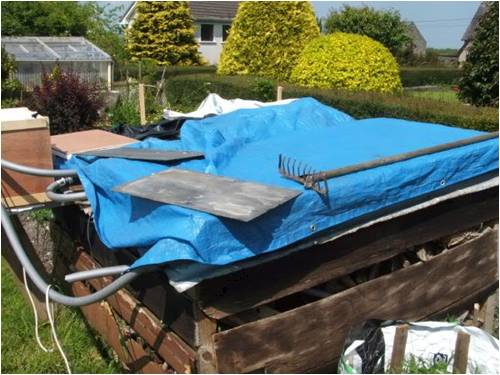
its nice to see a fully plumbed in system working like yours ... Edited by niall1 2011-06-08 Edited by niall1 2011-06-08
niall |
| |
MacGyver

Guru

Joined: 12/05/2009
Location: United StatesPosts: 1329 |
| Posted: 09:59pm 24 Jun 2011 |
 Copy link to clipboard Copy link to clipboard |
 Print this post |
|
An Improvement
The solar water heater works great, but I ran into a small problem based on the fact that the skies of late are more often overcast than clear. What's been happening is the water left over at the end of my shower, which would normally merely remain inside my insulated receiver (read that electric-assist water heater), has been losing its heat come the next day.
It takes the same amount of heat input to increase the temperature of hot water as it does cold water, so my thought was, "Why start over each day with cold water? Why not find a way to hold onto the already-solar-heated water in the receiver after my nightly shower?"
This problem is due to the fact that I have had the system running on a timer set for the normal clear-sky window of time. Of late, it's been first clear skies, then cloudy, then clear, then overcast, etc. I needed a way to tell the pump when to turn on so as not to export all my already-heated water to the roof, where the solar heater sitting in shade would act as a radiator and upload all my previously-stored heat to the atmosphere.
I was looking for a device on the order of those things that turn a lilght on when it gets dark. The only problem is, that sort of thing does the exact opposite. I want the circuit to come on when it's light outside and not dark. I even thought of building a simple electronic circuit when an idea on the order of a two by four being ejected (kicking back) from a table saw hit me right between the eyes and I knew how to solve the problem.
I found a fan limit switch normally used in a forced air unit (FAU) that energizes the fan to come on once the fire box hits a certain temperature. In a FAU, the fan circulates air across the hot fire box and then passes that air into the room keeping the room warm and the firebox cool. What I needed in my application was exactly the same thing.
Duh!
This is what I came up with this:
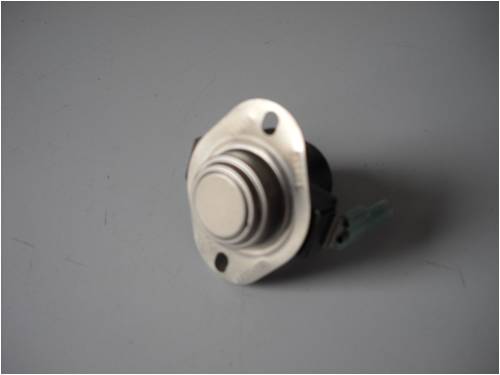
I got this at Johnstone Supply and you have to have a specialty contractor's
license to get one. If anyone in the US wants to do what I've done here
and is having trouble getting one of these, email or PM me and I'll help
you out. It's part number L36-481 AT021 Adj Snap Disk Thermostat

This thermostat is adjustable. There's a little slotted pointer on the
back side. The range is from 90* to 130* F. It is set to close
at the lower setting and open (as a safeguard) at 130*F. I don't want
the water to get any hotter than 130 anyways, so this is fine by me.
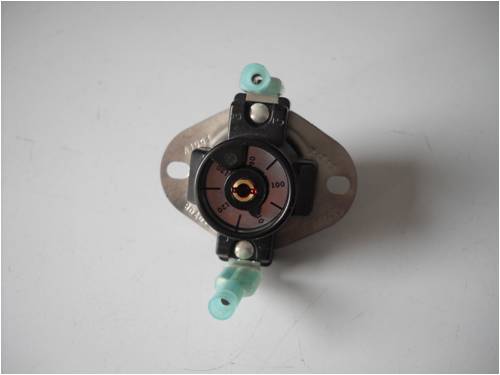
Here's another shot of the thermostat (therm=heat, stat=switch) from
the back side. All I did was slip open the clear polycarbonate covering
on the solar heater on my roof and insert this puppy such that the metal
on the switch lies on the aluminum heat sink in the collector, then ran the
wire out and down to the cord on my pump.
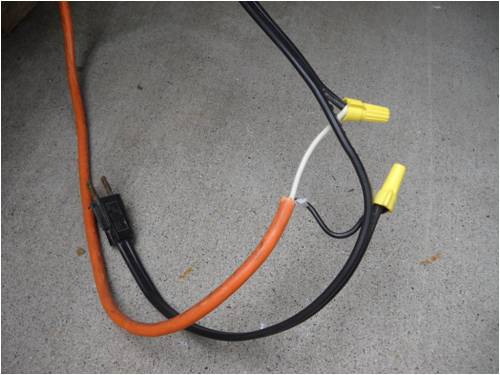
This is all I did at the pump cord end. I really should have housed it
in a junction box (J-box) but I didn't have one kicking around, so I did
the 'quick-'n-dirty'.
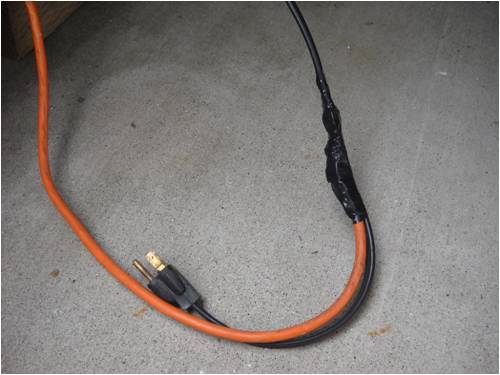
Since this pump runs from a GFCI circuit, I didn't want to have to be
resetting it all the time due to a ground fault caused by moisture, so
I ran two layers of electrician's tape over the connections.
Here's hoping my solar water heater challenges are a thing of the past. As soon as the temperature in my roof-top solar water heater collector reaches 95*F, the little circulating pump kicks in and runs the loop water from the receiver, through the collector and then back to the receiver. If clouds appear and the temperature drops below 95*F, the pump stops and I conserve whatever heat I've already stored below in the insulated receiver. If the temperature in the collector exceedes 130*F, the pump again shuts down, but that's just fine by me, cause I don't want SCALDING water in the thing even if it is free.
My hope is that this will help someone else out there to zero in of a free source of domestic hot water. I think I've jumped all the hurtles already. Like I said under one of the pictures, if anyone in the US wants to use a switch like this and lives in California and needs a contractor's license to buy the thing, contact me via email or PM and I'll get it for you and ship it on. I have a contractor's license, so they'll sell to me with no hassle.
Edit: Added Johnstone Supply part number to first photo caption.
Afterthought
It just occured to me that if the water in the receiver gets very, very hot, it could possibly keep the aluminum heat sink in the collector panel on the roof hot enough to "fool" the sensor and the pump would again run most of the stored hot water back to a cold roof depositing me right back where I started. To disable that function, I am leaving the timer in the circuit. That means after mean sundown or maybe an hour or two before, the timer will shut off the power to the circuit. That way, if things are roasty hot at sunset, I won't be wasting my free heat by the thermostat sensing heat, leaving the pump on.
In the morning after, even though there will be power in the circuit from about 9 a.m. on, the thermostat will initiate the pumping only after the inside temperature of the collector reaches its pre-set. By the way, I bumped that temp from 95*F to 110*F.
. . . . . MacEdited by MacGyver 2011-06-26
Nothing difficult is ever easy!
Perhaps better stated in the words of Morgan Freeman,
"Where there is no struggle, there is no progress!"
Copeville, Texas |
| |
| |
  Page 3 of 3 Page 3 of 3 |

